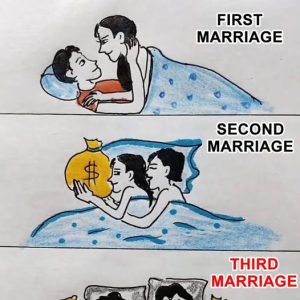Marriage, often seen as one of life’s most profound commitments, takes on different meanings and emotions depending on the chapter of life you’re in. Over time, as people evolve and their priorities shift, so does their understanding of what it means to share a life with someone. The contrast between a first, second, and third marriage reflects not just the differences in partners, but also the personal growth and changing values that come with age and experience. Each marriage tells a story—one that mirrors where you are in life, what you’ve learned, and what you now seek in love and companionship.

The first marriage is usually rooted in idealism. It’s driven by the excitement of starting a new journey with someone you love deeply. There’s a freshness to it, a sense of possibility, as two people come together to build a life from the ground up. Often, those entering their first marriage are young, filled with passion, and carry high hopes for the future. They imagine growing old together, starting a family, buying a home, and supporting each other through the highs and lows of life. There’s a dreamlike quality to it, one shaped by romance and optimism.
However, that same idealism can also lead to naivety. In a first marriage, both partners are still discovering themselves, their needs, and how to function within a long-term relationship. The lack of experience can result in misunderstandings, unmet expectations, and emotional missteps. What begins as a fairytale can sometimes become complicated by the realities of life—financial pressure, career demands, differing family backgrounds, or the simple challenge of growing at different paces. The first marriage is often where people learn the fundamentals of love: how to communicate, how to compromise, and how to confront conflict. Even if it ends in separation or divorce, it usually leaves behind valuable lessons that shape future relationships.
When someone enters into a second marriage, the tone is often different. The second time around tends to be more grounded, thoughtful, and intentional. This marriage is less about fulfilling a romantic ideal and more about finding someone who fits into the life you’ve already begun to build. By this stage, many people have experienced loss, heartbreak, or the disillusionment that can come from a relationship that didn’t go as planned. They’ve had time to reflect on what went wrong and what they need to do differently. That self-awareness brings a deeper sense of emotional maturity.
In second marriages, communication often becomes a top priority. Partners are more likely to express their needs clearly, establish boundaries, and seek mutual respect. There’s a practical approach to love—not in a cold or transactional way, but in a way that values stability, honesty, and shared purpose. For many, there are additional considerations such as children from previous relationships, blended families, or financial responsibilities that must be navigated together. These complexities can bring challenges, but they also foster deeper commitment and partnership. The second marriage, though sometimes quieter, can be stronger because it’s built on the lessons of the past and a sincere desire to build something lasting.
Then comes the third marriage, which often represents a season of life defined by clarity, contentment, and authenticity. By the time someone chooses to marry a third time, they usually have a solid understanding of who they are and what truly matters. Gone are the days of trying to meet societal expectations or impress others. The third marriage isn’t about proving anything—it’s about finding peace and joy in companionship. There’s less pressure and more presence. You’re not looking for perfection; you’re looking for someone who understands you, respects your journey, and wants to walk beside you in this next chapter.
Many people in their third marriage are older—perhaps retired or nearing retirement. They may have grown children, established routines, and a stronger appreciation for life’s simple pleasures. The relationship becomes more about emotional support, shared interests, and enjoying each other’s company without the weight of external obligations. It’s not uncommon for third marriages to feel like friendships at their core, built on deep respect and mutual understanding. There’s often more laughter, more patience, and a gentle acceptance of each other’s imperfections. The love in a third marriage may not be as fiery or impulsive, but it’s steady, genuine, and enduring.
What sets each marriage apart isn’t necessarily the partner or the circumstances, but the version of yourself that shows up to the relationship. Your first marriage reflects who you were when you were dreaming big, chasing love with open arms and an open heart. Your second marriage is the product of reflection, rebuilding, and redefining what love means after facing life’s setbacks. And your third marriage is where everything comes together—the experience, the maturity, the appreciation. It’s where love becomes less about grand gestures and more about quiet consistency.
That’s not to say one marriage is better than another. Each one holds its own value and offers its own unique journey. Some people find their soulmate in their first marriage and grow together through the decades. Others may not find lasting happiness until their second or third attempt. What matters most is the growth each experience brings. Every relationship, regardless of its outcome, teaches you something new—about trust, patience, forgiveness, and the power of real connection.
Ultimately, marriage is not a one-size-fits-all experience. It changes as we change. It reflects our hopes, our struggles, and our evolution as individuals. Whether it’s your first, second, or third time saying “I do,” each marriage represents a step forward in your understanding of love. And with each step, you become more capable of loving not just another person, but also yourself—fully, honestly, and without compromise.





